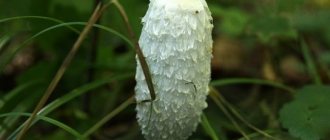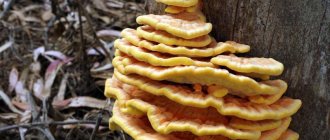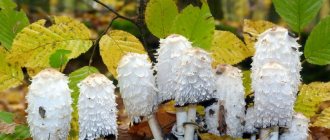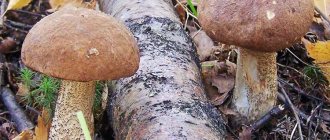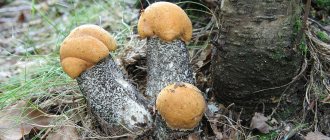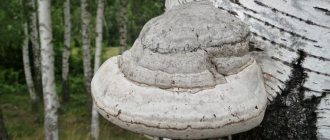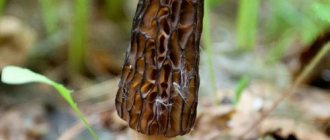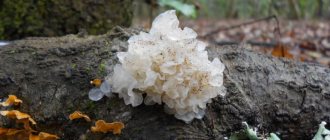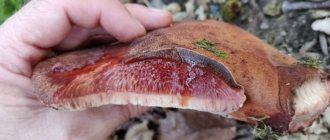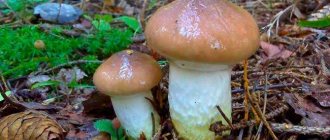White boletus (marsh) is a mushroom, widespread in the CIS countries, belongs to the genus Leccinum, family Boletaceae, group spongiform.
Marsh boletus is an edible mushroom of the 3rd category, less valuable than other boletus mushrooms due to its loose, highly boiled pulp and hard stem at the base. There is an opinion about the lower taste of the mushroom compared to other boletus mushrooms. Despite this, the use of boletus boletus in cooking is quite wide and you can prepare many tasty and healthy dishes with it.
Latin name : Leccinum holopus.
Another name : swamp birch (white), swamp, etc.
Related species
Boletus is a group of species of mushrooms of the genus Leccinum (boletus). In addition to boletus, this genus includes a group of boletus. Representatives of both groups are edible mushrooms.
In addition to the boletus boletus species, several dozen species are classified as boletus boletuses. The most common:
- common boletus – Leccinum scabrum;
- gray boletus (hornbeam) – Leccinum carpini;
- Stiff boletus – Leccinum duriusculum;
- black boletus (black cap) – Leccinum melaneum;
- pink boletus – Leccinum oxydabile;
- checkerboard boletus (blackening) – Leccinum nigrescens;
- ash-gray boletus – Leccinum leucophaeum;
- colorful boletus – Leccinum variicolor.
Black boletus Leccinum Melaneum
Black boletus Leccinum Melaneum
Also called Blackhead. This is a robust mushroom, one of the heaviest boletus mushrooms. Mushroom pickers note its strange feature - it is usually the least eaten by forest insects. Why is still a mystery.
Appearance
The cap is up to 16 cm in diameter, at first semicircular, in more mature mushrooms it is cushion-shaped, from dark brown to almost black. After rain it becomes sticky.
Tube-type plates, dirty white.
The leg is thick, up to 12 cm long, whitish, but strewn with dark scales, so sometimes it also looks dark.
The flesh is dense and hard, and may turn slightly blue when cut. Emits a satisfying mushroom smell.
Where It Grows
They bear fruit from late July to late autumn. The optimal collection time is August – September. Blackheads love moisture and grow on the banks of swamps and lakes. After heavy rains, they appear along the sides of roads and paths, among moss and thick grass on forest lawns, edges and clearings. Black boletus is found from Western Europe to Siberia.
False doubles
Boletuses are quite similar to each other, and since they are all edible, there will be no harm if, when collecting in a basket, for example, gray or marsh boletus gets in with the common boletus. It is much more important not to confuse them with poisonous mushrooms, which pose a threat not only to human health, but sometimes to human life.
The boletus boletus does not have a poisonous twin, but there are species that are externally similar to it and which cannot be eaten. How to distinguish marsh boletus?
False boletus
The false boletus or gall mushroom (Tylopilus felleus) is not poisonous, but it is also not suitable for food, since the taste of its pulp is very unpleasant, bitter, acrid, and does not disappear when cooked, but only intensifies. Even a small piece of false boletus can ruin the entire mushroom dish or preparation.
The main distinguishing features are:
- the presence of boletus boletus scales on the stem, in contrast to the gall mushroom, in which the stem is covered with a mesh pattern, reminiscent of a porcini mushroom, only dark in color;
- When cut, the flesh of the gall mushroom changes its color from white to pink, but in the boletus boletus the flesh does not change color.
Death cap
Pale toadstool (Amanita phalloides) is a deadly poisonous mushroom. In both species, the color of the cap is greenish-brown or white, but the pale grebe has a large ring on the stalk, formed from the remains of the spathe, which is absent in the marsh boletus.
Taste qualities of mushrooms
Swamp boletus differs from ordinary boletus in its loose pulp, which boils heavily, turns the broth dark and becomes not only ugly to look at, but also completely tasteless. In addition, it is advisable to take only young white ducks for food. It is recommended to cut only caps that are dry to the touch. Marsh boletus is not collected for preparations, because when salted and pickled, the pulp spreads in the liquid and becomes completely unappetizing. Loose pods have few characteristic aromatic compounds, and therefore young specimens are simply placed together with more valuable ones to increase the mass of the dish.
Warning! Beginning mushroom pickers need to remember that they don’t collect old white mushrooms, because they fall apart on the way home, and the loose pulp becomes unattractive.
Botanical description
The cap of the boletus boletus is thick and fleshy. The shape changes as the mushroom grows: at first it is semicircular, then becomes cushion-shaped. The skin is thin, smooth, dry, and in damp weather it becomes covered with light mucus. Color: whitish, cream, light brown with a grayish tint. Diameter: 2.5-16 cm.
The lower part of the cap (hymenophore) of the boletus boletus is a tube. The tubular layer is spongy and finely porous. The color starts out light, then changes to yellowish brown. Doesn't change when pressed.
Spores are smooth, fusiform. Color: olive yellow. Size: 15-20 x 5-6.5 microns. Spore powder is yellow-, olive-brown.
The stem of the boletus boletus is central, thin, dense, rounded, fibrous, covered with longitudinally arranged whitish scales. Colour: whitish, light grey. Height: 4-12 cm, diameter: 0.8-2 cm.
The pulp of boletus boletus is very soft and watery, especially in old mushrooms. Cap color: whitish, light yellow, stem color: bluish-green. Doesn't change when broken. There is no pronounced mushroom aroma. Taste: sour.
Places of distribution and time of collection
Various species are common in temperate climates, in deciduous forests and parks. They live in abundance under birch trees, and it is with this tree that the titular mycorrhiza forms, the common boletus . Tight fruiting bodies are found on the edges, clearings and along forest roads. The noble mushroom does not like acidic peat soils, preferring neutral loams or calcareous soils. The collection time is long - from the end of spring until the chilly autumn and the first frosts.
In swampy lowland forests, including on peat bogs, most often under birch trees, the mycelium of boletus . These fragile mushrooms appear in whole clearings, from July until the first frost.
In deciduous and deciduous-coniferous forests, under aspen and white poplar, you can find a rather rare mushroom, the severe boletus . It prefers calcareous soils and appears singly or in small families from July to mid-October.
On the sun-warmed edges and clearings of gloomy mossy forests, under birches and poplars, variegated caps of the multi-colored boletus . The species settles in small groups or singly; collection time is from July to early autumn.
Pink boletus is found in birch groves and mixed forests . More often it settles on the outskirts of swamps, on peat soils. This stable, but rather rare species forms mycorrhiza with birch and is distributed wherever this tree grows, right up to the tundra zone. The harvest takes a short period of time - from August to early October.
Mid-summer and early autumn is the time to collect black boletus mushrooms . Places of growth - damp lowlands of birch and mixed, most often birch-pine forests, the outskirts of swamps and clearings.
gray boletus or hornbeam grows in abundance . Fruiting bodies are collected in three waves: the first - during the flowering of rowan - in early summer; the second - in July, after haymaking; the third, autumn - in September-October.
Habitat
The boletus boletus is common in temperate regions of the Northern Hemisphere, more often on the Eurasian continent. It is found everywhere in the CIS. Prefers acidic and moist soils.
Where does boletus grow? The plant forms mycorrhiza (symbiosis with the roots of the plant) with birch, and therefore settles in close proximity to it.
Where to collect boletus boletus? The mushroom can be found in damp, mossy, swampy birch, as well as mixed and deciduous forests, near and in swamps. Usually grows solitary.
Where do white boletes (marsh boletus) grow?
Marsh boletuses grow under birch trees, on the roots of which a species of mycorrhiza settles; they are distributed throughout the middle zone in Europe and Asia, but are not common. Despite the name “swamp”, they do not grow in the swamps themselves, but they like to appear singly or in loose groups in damp, swampy places, on acidic soils. Expected and most likely habitats of swamp apes:
- damp birch groves;
- on the border of birch woodland and swamp;
- dry peat bogs;
- in the forest among mosses, especially sphagnum, because the species loves dampness and is nourished by the moisture that the moss retains.
Sometimes mushroom pickers report unusual finds: a family of boletus boletuses on a still standing trunk of a rotten birch tree.
The period of appearance of white caps is from the end of May until the first frosts, which begin in various areas at the end of October or November.
Chemical composition
Nutritional value depends on the chemical composition of boletus boletus. The mushroom contains protein, leucine, terosine, glutamine, organic acids, etc.
And also vitamin B1 (0.07 mg), B2 (0.22 mg), B9, E (0.1 mg), D, H, PP (6.7 mg), ascorbic acid (6 mg .), from macro- and microelements potassium (443 mg.), phosphorus (171 mg.), magnesium (15 mg.), calcium (6 mg.), sodium (3 mg.), manganese (0.74 mg. ), iron (0.3 mg.), cobalt, zinc, etc.
Important! The information presented in the material is for informational purposes only. Before use, be sure to consult a specialist.
Common names for boletus. Why is it called "baby"?
The boletus mushroom is called differently in different places: birch boletus, spikelet, obabok, babka, gray mushroom, black mushroom, blackhead, black mushroom. But of all the names for this mushroom, the most common (especially in the Urals and Siberia) has become obabok. Why has it spread so much? There is an opinion that this is due to the fact that mushrooms grow near the village, no one collects them, leaving them to grandmothers who cannot go far for good mushrooms. This is where the name “babies” comes from.
But another etymology is also possible. “Being crazy,” according to V. Dahl’s dictionary, means for a man to become lethargic and whiny. By nature, boletus is just like this: the older it is, the more shapeless, watery, looser it is. In general, in my youth I was no worse than other mushrooms, but suddenly I became crazy.
Young boletus is strong, dense, in no way inferior to aspen boletus. As they grow and increase in size, the dogs begin to soften and quickly lose their vigorous appearance.
Calories and nutritional value
The boletus boletus plant is a valuable food product, contains a rich set of vitamins, macro- and microelements, and is a plant source of protein. At the same time, the calorie content of boletus boletus is low (per 100 grams of product):
| Name | Quantity, gr. |
| Calories, kcal | 20 |
| Squirrels | 2,1 |
| Fats | 0,8 |
| Carbohydrates | 1,2 |
| Water | 90,1 |
| Cellulose | 5,1 |
How to collect
The main harvesting season for boletus boletus begins in July and lasts until October. However, the first specimens may appear in early May. Since the mushroom is not afraid of cold weather, boletus boletus can be found even until frost.
The flesh of the mushroom cap is loose, flabby, and raw. And with age, these properties of boletus boletus increase. Therefore, only young specimens are suitable for collection. Old mushrooms become so wet that it is impossible to bring them home; they turn into a slippery mass.
Found boletus mushrooms are cut with a sharp knife, carefully so as not to damage the mycelium, at a distance of 1.5-2 cm from the ground.
How to distinguish boletus from boletus?
Despite their eloquent names, these mushrooms, belonging to the same genus, can settle under aspens, and under birches, and under the canopy of many other trees.
Young mushrooms, especially light-colored species, are difficult to distinguish, and to more accurately determine the species, it is better to look for adult specimens. They are distinguished by the color of the skin, the structure and color of the pulp when broken.
In general the colors of boletus mushrooms are more modest, often in gray-brown or brown tones; boletus mushrooms are brighter - their caps are reddish-brown and orange-yellow. However, this difference is not always characteristic - the common boletus and the red boletus are similar in their chestnut-red caps, and both of these species can grow side by side.
An experienced mushroom picker will distinguish boletus by the structure of the pulp - it is more porous, loose, becomes watery with age and, when broken, does not darken or changes color slightly - often turning pink.
Boletus
Boletuses are characterized by tight flesh, which quickly turns color when cut - turns blue, purple or brown. The fruiting bodies are hard and are not destroyed by heat treatment, and therefore these species are often preferable to boletus mushrooms.
Both mushrooms are edible, have excellent quality and can be safely eaten - they are suitable for drying, pickling and any culinary delights.
How to cook
The mushroom is quite tasty, so in cooking boletus boletus is used for boiling, frying, and stewing. If you use young specimens, they retain their density after heat treatment, including after boiling.
The stem of the mushroom is quite hard and fibrous, so there are recommendations to remove it completely and use only the caps for cooking.
As for the preparations, due to the peculiarities of the flesh of the cap, the boletus boletus is not suitable for pickling, since it does not hold its shape at all and simply “spreads” in the marinade. For pickling, use exclusively dry salted boletus boletus recipe.
Use
The swamp mushrooms quickly become a viscous mass, unsuitable for consumption, so they are sorted and cooked immediately. Fresh or dried caps are baked and fried, cooked in soups, sauces, used as an ingredient in vegetable stews, but not salted or pickled. Cook for at least 25-30 minutes. The finished mushroom mass sinks to the bottom. Marsh boletuses are fried in sunflower oil. The downside to all of this is that the liquid turns dark when cooked.
Advice! Soup made from marsh boletuses will not darken too much if they are blanched before cooking: put in boiling water for 5-10 minutes and rinsed with cold water.
Cooking recipes
Cooking
How to cook boletus boletus? Bring salted water (1 tablespoon of salt per 2 liters of water) to a boil, place the prepared mushrooms in it. Cook for about half an hour, constantly skimming off the foam.
A sign that the mushrooms are ready is when they settle to the bottom.
Frying
How to fry marsh boletus? To prepare 1 kg of mushrooms (caps) you will need:
- onions – 300 gr.,
- garlic – 3-4 cloves;
- ground black pepper, salt to taste;
- vegetable oil.
Cut the prepared mushroom caps into 2-4 pieces. Peel the onion and chop finely.
Fry chopped garlic in hot oil until golden brown. Remove it with a spoon or slotted spoon; it will no longer be useful. Then pour the mushrooms into the frying pan and fry, stirring, until the moisture evaporates.
Add the onion and stir until soft. Salt and pepper. You can add other spices if you wish.
Boiled potatoes are a good side dish for fried boletus mushrooms.
Black boletus Léccinum crocipodium
Blackening boletus Léccinum crocipódium
Better known as Blackening boletus. Prefers oak and beech to birch.
Appearance
The cap is from 5 to 15 cm in diameter, yellow-brown, very dry. Changes shape from convex to cushion-shaped as the mushroom ages.
The plates are tubular, lemon-yellow in color.
The leg is up to 12 cm high and up to 3 cm thick, cylindrical, with a thickening at the bottom. The shade of the leg is yellowish, it is covered with darker scales, which turn into a mesh at the base.
The flesh is light yellow and soft, becomes juicy red when cut, then becomes very dark - hence the name of this species.
Where It Grows
It grows in groups and singly from June to October in deciduous forests next to oak and beech in the southern regions of Russia, the Caucasus and southern Europe.
Contraindications
Whatever the useful product and whatever gastronomic qualities it has, before consuming it is always necessary to take into account not only the benefits, but also the contraindications of boletus boletus. Dishes containing this mushroom should not be consumed if:
- diseases of the gastrointestinal tract, liver, gall bladder and kidneys in the acute stage;
- stomach ulcer,
- cirrhosis,
- hepatitis,
- pancreatitis,
- schizophrenia,
- pregnant women,
- women during breastfeeding,
- children under 7 years old.
Sources:
T.A. Ilyina. Mushrooms, Atlas-identifier.
A.P. Umeltsev. Encyclopedia of mushroom picker.
Anna Romanova, Alla Bulatova. Mushrooms. Illustrated guide to collection, processing, storage.
Vladimir Onishchenko. Mushroom Picker's Guide.
Mikhail Vishnevsky. Mushrooms. Key to mushrooms of Russian forests and fields
Interesting Facts
Bolotnik.
Marsh boletus (like all boletus in general) contains a lot of dietary fiber, so it removes toxins from the digestive tract well. Boletus mushrooms exhibit antimicrobial and immunostimulating effects, and also contain many vitamins. Mushrooms are very nutritious and low in calories. By the way, absolutely all boletus mushrooms are edible.
Despite the fact that boletus mushrooms are tasty, healthy and do not pose a risk of poisoning, pregnant women and those who are breastfeeding, children and adults who suffer from digestive ailments should not eat them.

